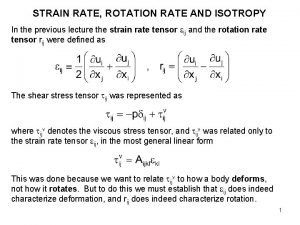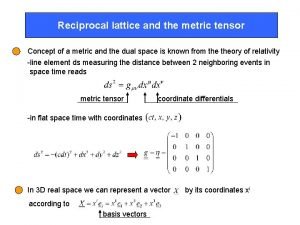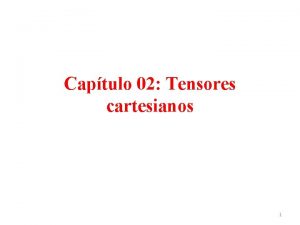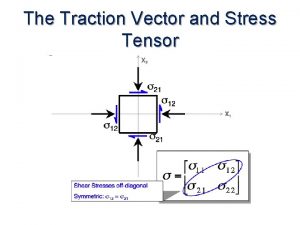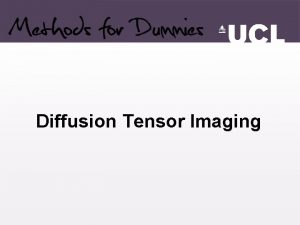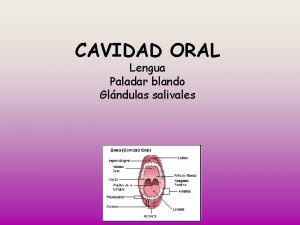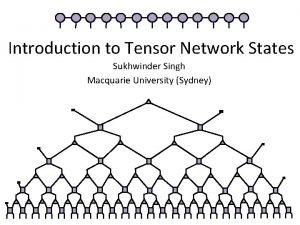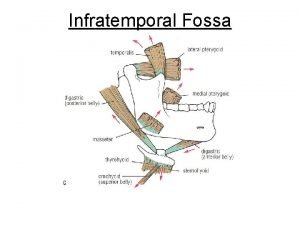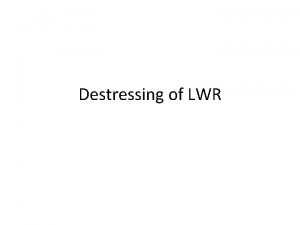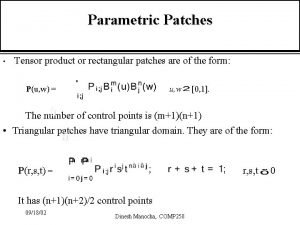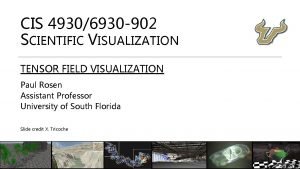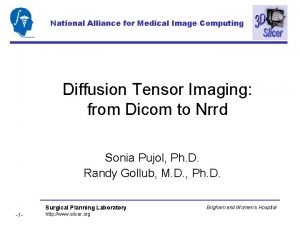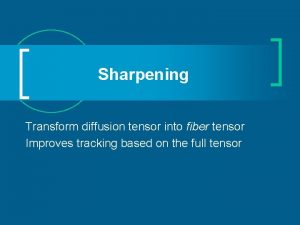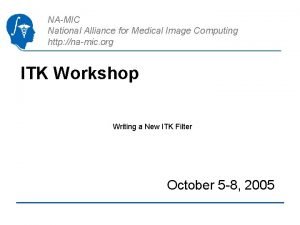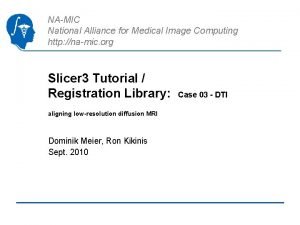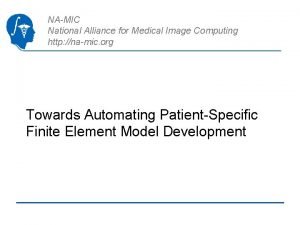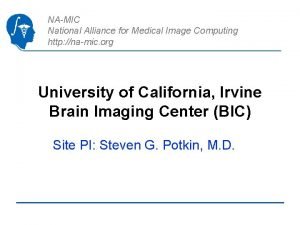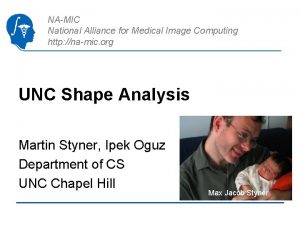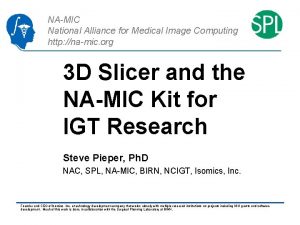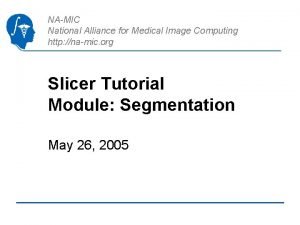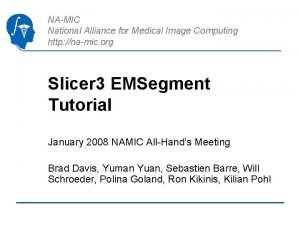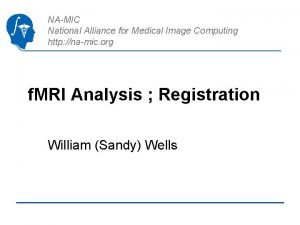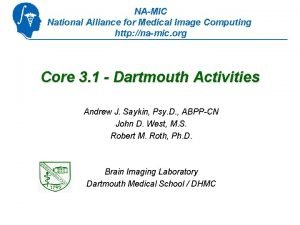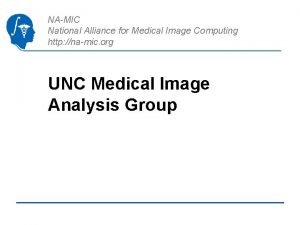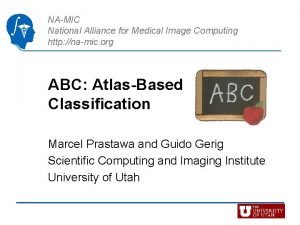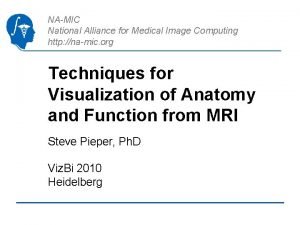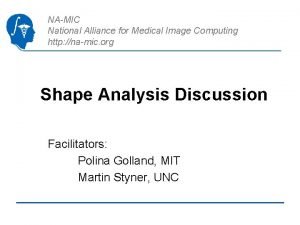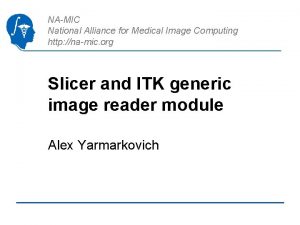National Alliance for Medical Image Computing Diffusion Tensor






































































































































- Slides: 134

National Alliance for Medical Image Computing Diffusion Tensor Imaging Sonia Pujol, Ph. D. Randy Gollub, M. D. , Ph. D. Surgical Planning Laboratory -1 - http: //www. slicer. org Brigham and Women’s Hospital

Acknowledgments National Alliance for Medical Image Computing NIH U 54 EB 005149 Neuroimage Analysis Center NIH P 41 RR 013218 Laboratory of Mathematics in Imaging, Brigham and Women’s Hospital Thanks to Carl-Fredrik Westin, Lauren O’Donnell, Raul San Jose Estepar, Carlos Isorna, Maxime Boucher, Matthan Caan Surgical Planning Laboratory -2 - http: //www. slicer. org Brigham and Women’s Hospital

Material • Slicer 2. 6 http: //www. na-mic. org/Wiki/index. php/Slicer: Slicer 2. 6_Getting_Started • DTI Sample Data Set Dwi-dicom. zip Slicer. Sample. DTI. zip http: //www. na-mic. org/Wiki/index. php/Slicer: Workshops: User_Training_101 Surgical Planning Laboratory -3 - http: //www. slicer. org Brigham and Women’s Hospital

Goal of this tutorial Guiding you step-by-step through the DWI data analysis capabilities of Slicer, including generation of tensors, calculation of scalar metrics and tractography tools. Final result of the tutorial Surgical Planning Laboratory -4 - http: //www. slicer. org Brigham and Women’s Hospital

Slicer DT-MRI Module Surgical Planning Laboratory -5 - http: //www. slicer. org Brigham and Women’s Hospital

Overview • • • Part 1: Loading and Converting DTI Data Part 2: Computing Fractional Anisotropy Part 3: Generating Fiber Tracts Part 4: Selective Seeding Part 5: Clustering Surgical Planning Laboratory -6 - http: //www. slicer. org Brigham and Women’s Hospital

Diffusion Weighted Imaging (DWI) Diffusion Sensitizing Gradients Surgical Planning Laboratory -7 - http: //www. slicer. org Diffusion Weighted Images Brigham and Women’s Hospital

Diffusion Weighted Imaging (DWI) Example: Correlation between the orientation of the 11 th gradient and the signal intensity in the Splenium of the Corpus Callosum Surgical Planning Laboratory -8 - http: //www. slicer. org Brigham and Women’s Hospital

Loading DTI Data Slicer can load • DWI Volumes …………. • Tensors……………… • Tracts……………… • DTI Scenes ……………. Surgical Planning Laboratory -9 - http: //www. slicer. org Brigham and Women’s Hospital

DWI Training Dataset 1 • 2 Baselines and 12 Gradients Surgical Planning Laboratory -10 - http: //www. slicer. org Brigham and Women’s Hospital

DWI Training Dataset 2 • 1 Baseline and 6 Gradients Surgical Planning Laboratory -11 - http: //www. slicer. org Brigham and Women’s Hospital

Loading the DWI Training Dataset 1 Click on Add Volume to load the Dicom-DWI training dataset Surgical Planning Laboratory -12 - http: //www. slicer. org Brigham and Women’s Hospital

Loading DWI data The Props Panel of the module Volumes appears. Select Nrrd Reader in the Properties field Surgical Planning Laboratory -13 - http: //www. slicer. org Brigham and Women’s Hospital

Loading DWI data Click on Browse and load the file namic 01 -dwi. nhdr in the directory Dwi-dicom Check that the path to the file is correct. If needed, manually enter it Click on Apply Surgical Planning Laboratory -14 - http: //www. slicer. org Brigham and Women’s Hospital

Loading DWI data Slicer loads the Nrrd DWI dataset Surgical Planning Laboratory -15 - http: //www. slicer. org Brigham and Women’s Hospital

Loading DWI data Left-click on the button Or, and select the orientation Slices Surgical Planning Laboratory -16 - http: //www. slicer. org Brigham and Women’s Hospital

Loading DWI data The anatomical slices are now aligned with the sampling grid Surgical Planning Laboratory -17 - http: //www. slicer. org Brigham and Women’s Hospital

Loading DWI data Change the FOV to 2000 Surgical Planning Laboratory -18 - http: //www. slicer. org Brigham and Women’s Hospital

Loading DWI data The sagittal and coronal viewers display the 14 MR volumes: 2 baselines and 12 diffusion weighted volumes Surgical Planning Laboratory -19 - http: //www. slicer. org Brigham and Women’s Hospital

Loading DWI data Left-Click on the V button to display the axial and sagittal slices inside the viewer. Use the axial slider to slice trough the baselines and diffusion weighted MR volumes. Surgical Planning Laboratory -20 - http: //www. slicer. org Brigham and Women’s Hospital

DT-MRI Module Select Modules in the Main Menu Select Visualisation DTMRI Surgical Planning Laboratory -21 - http: //www. slicer. org Brigham and Women’s Hospital

DT-MRI Module The panel Input of the DTMRI module appears Click on the tab Conv Surgical Planning Laboratory -22 - http: //www. slicer. org Brigham and Women’s Hospital

DT-MRI Module The panel Conv of the DTMRI module appears Surgical Planning Laboratory -23 - http: //www. slicer. org Brigham and Women’s Hospital

Converting DWI data to tensors Select the Input Volume namic 01 -dwi. nhdr and click on Convert. Volume Surgical Planning Laboratory -24 - http: //www. slicer. org Brigham and Women’s Hospital

Converting DWI data to tensors (Stejskal and Tanner 1965, Basser 1994 ) Dxx Dyx Dzx Dxy Dyy Dzy Dxz Dyz Dzz Surgical Planning Laboratory -25 - http: //www. slicer. org {Si} represent the signal intensities in presence of the gradients gi Slicer computes the symmetric 3 x 3 tensor matrix D for each voxel Brigham and Women’s Hospital

Converting DWI data to tensors • At the end of the calculation, Slicer displays the average of all diffusion weighted images (_Av. Gradient) and the baseline volume (_Baseline). • The tensors volume is available from the DTMRI module for additional calculations. Surgical Planning Laboratory -26 - http: //www. slicer. org Brigham and Women’s Hospital

Converting DWI data to tensors Slicer displays the anatomical views of the average of all 12 diffusion weighted images (average over all gradient directions) Surgical Planning Laboratory -27 - http: //www. slicer. org Brigham and Women’s Hospital

Adjusting Window Level Click on the Module Volumes and select the tab Display Surgical Planning Laboratory -28 - http: //www. slicer. org Brigham and Women’s Hospital

Adjusting Window Level Select the Active Volume namic 01 -dwi-nhdr_Av. Gradient Use the sliders Win and Lev to adjust the Window level Surgical Planning Laboratory -29 - http: //www. slicer. org Brigham and Women’s Hospital

Adjusting Window Level Slicer displays the anatomical views of the average of all 12 diffusion weighted images (average over all gradient directions) Inspect the anatomy using the axial, sagittal and coronal sliders. Surgical Planning Laboratory -30 - http: //www. slicer. org Brigham and Women’s Hospital

Converting DWI data to tensors Left-click on Bg and select the volume namic 01 -dwi nhdr_Baseline Surgical Planning Laboratory -31 - http: //www. slicer. org Brigham and Women’s Hospital

Converting DWI data to tensors Slicer displays the baseline (T 2) images. Browse the baseline images to check if the anatomy is correct Surgical Planning Laboratory -32 - http: //www. slicer. org Brigham and Women’s Hospital

Converting DWI data to tensors Click on the module Data Slicer displays the list of DTI volumes Surgical Planning Laboratory -33 - http: //www. slicer. org Brigham and Women’s Hospital

Converting DWI data to tensors Select File Close in the Main Menu to clear the scene Surgical Planning Laboratory -34 - http: //www. slicer. org Brigham and Women’s Hospital

Loading the DWI Training Dataset 2 Click on Add Volume Surgical Planning Laboratory -35 - http: //www. slicer. org Brigham and Women’s Hospital

Loading Slicer Sample DWI data Select the Props Panel Use the Basic Reader Click on Browse Navigate to the folder containing the tutorial data Select the first file D. 001 Click Open Select Image. Headers: Auto Click Apply Surgical Planning Laboratory -36 - http: //www. slicer. org Brigham and Women’s Hospital

Loading Slicer Sample DWI data The DWI images appear in the Viewer Surgical Planning Laboratory -37 - http: //www. slicer. org Brigham and Women’s Hospital

Loading Slicer Sample DWI data Observe the axial slices using the slider Surgical Planning Laboratory -38 - http: //www. slicer. org Brigham and Women’s Hospital

Loading Slicer Sample DWI data A sequence of white stripes appears in the diffusion weighted images. They correspond to intersections with the baseline images in Slicer Axial/Sagittal/Coronal (Axi. Sag. Cor) slice mode. Surgical Planning Laboratory -39 - http: //www. slicer. org Brigham and Women’s Hospital

Loading Slicer Sample DWI data Superior In Axial/Sagittal/Coronal mode the slices planes, which are aligned with the RAS coordinates, are cutting through the DWI volume Surgical Planning Laboratory -40 - http: //www. slicer. org Inferior Brigham and Women’s Hospital

Loading Slicer Sample DWI data Left click on Or and select the orientation Slices in the Menu Surgical Planning Laboratory -41 - http: //www. slicer. org Brigham and Women’s Hospital

Loading Slicer Sample DWI data The original slices appear in the Viewer Surgical Planning Laboratory -42 - http: //www. slicer. org Brigham and Women’s Hospital

Loading Slicer Sample DWI data Superior In Axi. Slice/Sagi. Slice/Cor. Slice mode the slices are aligned with the DWI volume Surgical Planning Laboratory -43 - http: //www. slicer. org Inferior Brigham and Women’s Hospital

Loading Slicer Sample DWI data Notice that the viewer displays the stack of S 0 and diffusion weighted images {Si} Surgical Planning Laboratory -44 - http: //www. slicer. org Brigham and Women’s Hospital

Loading Slicer Sample DWI data Browse the original axial slices corresponding to the baseline (S 0) image. Example: display the slice 209 Surgical Planning Laboratory -45 - http: //www. slicer. org Brigham and Women’s Hospital

Loading Slicer Sample DWI data Adjust the window level and observe the baseline image (S 0) Surgical Planning Laboratory -46 - http: //www. slicer. org Brigham and Women’s Hospital

Adjusting Image Window Level Select the Volumes module Select the Display panel Select the volume D Adjust Window and Level Surgical Planning Laboratory -47 - http: //www. slicer. org Brigham and Women’s Hospital

Loading Slicer Sample DWI data Observe the baseline image (S 0) Surgical Planning Laboratory -48 - http: //www. slicer. org Brigham and Women’s Hospital

Loading Slicer Sample DWI data Notice that the image intensity for each of the six gradient orientations is much lower than the S 0 image. Surgical Planning Laboratory -49 - http: //www. slicer. org Brigham and Women’s Hospital

DT-MRI Module Select Modules in the Main Menu Select Visualization DTMRI Surgical Planning Laboratory -50 - http: //www. slicer. org Brigham and Women’s Hospital

DT-MRI Module Select the module DTMRI Select the Conversion Panel: Conv Surgical Planning Laboratory -51 - http: //www. slicer. org Brigham and Women’s Hospital

Convert DWI data to tensors Select Input. Volume D Select Protocol BWH_6 g. 1 b. Slice Click on Prop to display the parameters of the acquisition protocol Surgical Planning Laboratory -52 - http: //www. slicer. org Brigham and Women’s Hospital

Acquisition protocol Slicer displays the parameters of the acquisition protocol used to acquire the DTI Sample Data BWH_6 g. 1 b. Slice at Brigham and Women’s Hospital, corresponding to: • n=6 gradients • Gradient directions = {0. 707107 0} , {0 0. 707107 }, {0. 707107 0 0. 707107 }, {0 0. 707107 -0. 707107 }, {0. 707107 -0. 707107 0}, {-0. 707107 0 0. 707107} • Gradient order: Slice interleaved • b=1 baseline • B-value = 1000 Surgical Planning Laboratory -53 - http: //www. slicer. org Brigham and Women’s Hospital

Convert DWI data to tensors Click on Convert Volume Surgical Planning Laboratory -54 - http: //www. slicer. org Brigham and Women’s Hospital

Converting DWI data to tensors Slicer displays the anatomical views of the average of all 6 diffusion weighted images Surgical Planning Laboratory -55 - http: //www. slicer. org Brigham and Women’s Hospital

Converting DWI data to tensors Left Click on the button Bg and select the volume D_Baseline Surgical Planning Laboratory -56 - http: //www. slicer. org Brigham and Women’s Hospital

Converting DWI data to tensors Observe the volume D_Baseline Surgical Planning Laboratory -57 - http: //www. slicer. org Brigham and Women’s Hospital

Overview • • • Part 1: Loading and Converting DTI Data Part 2: Computing Fractional Anisotropy Part 3: Generating Fiber Tracts Part 4: Selective Seeding Part 5: Clustering Surgical Planning Laboratory -58 - http: //www. slicer. org Brigham and Women’s Hospital

Computing Fractional Anisotropy In the DT-MRI module, click on More to navigate in the different panels Surgical Planning Laboratory -59 - http: //www. slicer. org Brigham and Women’s Hospital

Computing Fractional Anisotropy Select the panel Scalars Browse the menu Create Volume to see the list of calculations that Slicer can perform on the D_Tensor dataset. Select Fractional Anisotropy Surgical Planning Laboratory -60 - http: //www. slicer. org Brigham and Women’s Hospital

Computing Fractional Anisotropy • The Fractional Anisotropy (FA) is a measure of the diffusion anisotropy that can be calculated without explicitly computing any eigenvalue: where |D| and trace(D) are the norm and trace of the Diffusion Tensor. Surgical Planning Laboratory -61 - http: //www. slicer. org Brigham and Women’s Hospital

Computing Fractional Anisotropy The Fractional Anisotropy Panel appears Select the Region of Interest ROI: Mask The Scale Factor is set by default to 1000, because the standard range of FA values (0. 0 to 1. 0) is not compatible with Slicer Click on Apply Surgical Planning Laboratory -62 - http: //www. slicer. org Brigham and Women’s Hospital

Computing Fractional Anisotropy The Viewer displays the FA volume. Move the mouse in the slices to see FA values for each voxel. Surgical Planning Laboratory -63 - http: //www. slicer. org Brigham and Women’s Hospital

Computing Fractional Anisotropy • Note high FA values over large tracts such as the corpus callosum • Note low FA values over gray matter Surgical Planning Laboratory -64 - http: //www. slicer. org Brigham and Women’s Hospital

Fractional Anisotropy Statistics Goal Measure Fractional Anisotropy Statistics in a Region of Interest (ROI) Surgical Planning Laboratory -65 - http: //www. slicer. org Brigham and Women’s Hospital

ROI Drawing Select the Editor module in the main Menu. Select the Volumes panel. Select the Original Grayscale Fractional. Anisotropy_D Select the Working Labelmap NEW and keep the Default Descriptive Name Working. Click on Start Editing Surgical Planning Laboratory -66 - http: //www. slicer. org Brigham and Women’s Hospital

ROI Drawing Select the Effects panel Left click on Draw in the Effects Menu Surgical Planning Laboratory -67 - http: //www. slicer. org Brigham and Women’s Hospital

ROI Drawing The Draw Panel of the Editor Module appears Left-click on Output, and select the color label #2 (pink) Surgical Planning Laboratory -68 - http: //www. slicer. org Brigham and Women’s Hospital

ROI Drawing Draw the contour of the Corpus Callosum with the mouse in the sagittal slice Surgical Planning Laboratory -69 - http: //www. slicer. org Brigham and Women’s Hospital

ROI Drawing Click on Apply in the Editor Module Surgical Planning Laboratory -70 - http: //www. slicer. org Brigham and Women’s Hospital

Measure FA Statistics in ROI Select Modules Measurement Volume. Math in the Main Menu Surgical Planning Laboratory -71 - http: //www. slicer. org Brigham and Women’s Hospital

Mask. Stat Select Mask. Stat The Mask. Stat functionality uses the labelmap as a mask over the FA volume, and calculates “stats” on the region contained under the labelmap. Surgical Planning Laboratory -72 - http: //www. slicer. org Brigham and Women’s Hospital

Mask. Stat Set Volume to Mask to Fractional. Anisotropy_D_Tensor Set Label. Map to Working Set Masked Output to Create New Surgical Planning Laboratory -73 - http: //www. slicer. org Brigham and Women’s Hospital

Mask. Stat Click on Mask, select the same color as your labelmap Click on Browse to select a directory to place the output text file and enter the file name Fractional. Anisotropy_D_Tensor_hist. txt Click on Run Surgical Planning Laboratory -74 - http: //www. slicer. org Brigham and Women’s Hospital

Mask. Stat Result A window shows the statistics (multiplied by the Scale Factor): minimal, maximal, mean and standard deviation of the FA values. The results have been saved in the file Fractional. Anisotropy_D_Tensor_hist. txt written on the disk. Surgical Planning Laboratory -75 - http: //www. slicer. org Brigham and Women’s Hospital

Save FA volume and ROI Select the module Editor Select the panel Volumes and click on Save Enter a Filename. Prefix and select the format NRRD(. nhdr) Click on Save Surgical Planning Laboratory -76 - http: //www. slicer. org Brigham and Women’s Hospital

Save FA volume and ROI Slicer generates a Nrrd header file (FA. nhdr), and a raw compressed file (FA. raw. gz). Save the Working volume containing the label map using the same process. (Slicer Training #7: Saving data. ) Surgical Planning Laboratory -77 - http: //www. slicer. org Brigham and Women’s Hospital

Overview • • • Part 1: Loading and Converting DTI Data Part 2: Computing Fractional Anisotropy Part 3: Generating Fiber Tracts Part 4: Selective Seeding Part 5: Clustering Surgical Planning Laboratory -78 - http: //www. slicer. org Brigham and Women’s Hospital

Tractography Panel Select the DTMRI module and click on the Panel More Select the Panel Tracts inside the DTMRI module Surgical Planning Laboratory -79 - http: //www. slicer. org Brigham and Women’s Hospital

Tractography Panel Select the Tab Settings Left-click on Color Surgical Planning Laboratory -80 - http: //www. slicer. org Brigham and Women’s Hospital

Tractography Panel A Color selection panel appears Select a new color for the tracts Surgical Planning Laboratory -81 - http: //www. slicer. org Brigham and Women’s Hospital

Create a single tract Position the mouse on a point inside the Corpus Callosum, and hit the s key. Surgical Planning Laboratory -82 - http: //www. slicer. org Brigham and Women’s Hospital

Create a single tract A tract appears in the 3 D Viewer. Drag right mouse button down in the 3 D Viewer to zoom in. Surgical Planning Laboratory -83 - http: //www. slicer. org Brigham and Women’s Hospital

Create a single tract The 3 D window shows a closer view of the tract. Click on the V buttons Surgical Planning Laboratory -84 - http: //www. slicer. org Brigham and Women’s Hospital

Create a single tract Slicer displays the slices in the 3 D window. Drag left mouse button in the 3 D Viewer to rotate the volume, Drag right mouse button to zoom in, until you get to a convenient view. Surgical Planning Laboratory -85 - http: //www. slicer. org Brigham and Women’s Hospital

Generate Multiple Tracts Position the mouse on different points in the corpus callosum and hit the s key. Surgical Planning Laboratory -86 - http: //www. slicer. org Brigham and Women’s Hospital

Generate Multiple Tracts The tracts that correspond to the visited points appear in the 3 D Viewer. Surgical Planning Laboratory -87 - http: //www. slicer. org Brigham and Women’s Hospital

Generate Multiple Tracts Hold down the s key and move the mouse in the corpus callosum Surgical Planning Laboratory -88 - http: //www. slicer. org Brigham and Women’s Hospital

Generate Multiple Tracts Multiple tracts are generated for each point visited by the mouse. Surgical Planning Laboratory -89 - http: //www. slicer. org Brigham and Women’s Hospital

ROI Seeding Slicer has functionalities to generate tracts from a pre-defined Region Of Interest (ROI). Training dataset ROI: • ROI 1: Temporal stem, between frontal and temporal lobes • ROI 2: Posterior temporal lobe • ROI 3: Splenium of the corpus callosum Surgical Planning Laboratory -90 - http: //www. slicer. org Brigham and Women’s Hospital

ROI Drawing Select the Editor module in the main Menu. Select the Volumes panel and click Setup Select the Original Grayscale Fractional. Anisotropy_D_Tensor Select the Labelmap Working. Click on Start Editing Surgical Planning Laboratory -91 - http: //www. slicer. org Brigham and Women’s Hospital

ROI Drawing Select the Effects panel Left click on Draw in the Effects Menu Surgical Planning Laboratory -92 - http: //www. slicer. org Brigham and Women’s Hospital

ROI Drawing Select the color label #7 in the module Editor Surgical Planning Laboratory -93 - http: //www. slicer. org Brigham and Women’s Hospital

ROI 1: Temporal stem Select View 1 x 512 COR in the Main Menu Draw a region of interest in the Temporal stem (slice #156) Click on Apply in the module Editor Surgical Planning Laboratory -94 - http: //www. slicer. org Brigham and Women’s Hospital

ROI Drawing Select the color label #10 in the module Editor Surgical Planning Laboratory -95 - http: //www. slicer. org Brigham and Women’s Hospital

ROI 2: Posterior temporal lobe Select View 1 x 512 COR in the Main Menu. Draw a region of interest in the Posterior Temporal Lobe (slice #128) Click on Apply in the module Editor Surgical Planning Laboratory -96 - http: //www. slicer. org Brigham and Women’s Hospital

ROI Drawing Select the color label #5 in the module Editor Surgical Planning Laboratory -97 - http: //www. slicer. org Brigham and Women’s Hospital

ROI 3: Splenium Select View 1 x 512 SAG in the Main Menu. Draw a region of interest in the Splenium of the Corpus Callosum (slice #131) Click on Apply in the module Editor. Surgical Planning Laboratory -98 - http: //www. slicer. org Brigham and Women’s Hospital

ROI Seeding Come back to the DTMRI module and select the panel Tracts. Click on the tab Seed and select the Seed. ROI Working Select the color label #7 corresponding to the ROI 1 Surgical Planning Laboratory -99 - http: //www. slicer. org Brigham and Women’s Hospital

ROI Seeding Click on Seed Tracts A warning message appears, Click Yes if you are ready to process the data. Surgical Planning Laboratory -100 - http: //www. slicer. org Brigham and Women’s Hospital

ROI 1 Seeding Slicer displays the tracts from ROI 1 Surgical Planning Laboratory -101 - http: //www. slicer. org Brigham and Women’s Hospital

ROI Seeding Select the color label #10 corresponding to the ROI 2 Click on Seed Tracts A warning message appears, Click Yes if you are ready to process the data. Surgical Planning Laboratory -102 - http: //www. slicer. org Brigham and Women’s Hospital

ROI 2 Seeding Slicer displays the tracts from ROI 2 Surgical Planning Laboratory -103 - http: //www. slicer. org Brigham and Women’s Hospital

ROI Seeding Select the color label #5 corresponding to the ROI 3 Click on Seed Tracts A warning message appears, Click Yes if you are ready to process the data. Surgical Planning Laboratory -104 - http: //www. slicer. org Brigham and Women’s Hospital

ROI 3 Seeding Slicer displays the tracts from ROI 3 Surgical Planning Laboratory -105 - http: //www. slicer. org Brigham and Women’s Hospital

Selective Seeding Slicer displays the tracts from the 3 segmented ROIs Surgical Planning Laboratory -106 - http: //www. slicer. org Brigham and Women’s Hospital

Overview • • • Part 1: Loading and Converting DTI Data Part 2: Computing Fractional Anisotropy Part 3: Generating Fiber Tracts Part 4: Selective Seeding Part 5: Clustering Surgical Planning Laboratory -107 - http: //www. slicer. org Brigham and Women’s Hospital

Selective Seeding AND and NOT operators can be used to select tracts generated from different Regions Of Interest. Surgical Planning Laboratory -108 - http: //www. slicer. org Brigham and Women’s Hospital

Selective Seeding Slicer displays the tracts from the 3 segmented ROIs Surgical Planning Laboratory -109 - http: //www. slicer. org Brigham and Women’s Hospital

AND/NOT operators: example • ROI 1: Temporal stem, between frontal and temporal lobes • ROI 2: Posterior temporal lobe • ROI 3: Splenium of the corpus callosum • Target: Inferior Occipito-frontal Fasciculus from the Frontal lobe to Occipital Lobe, through Temporal lobe Surgical Planning Laboratory -110 - http: //www. slicer. org Brigham and Women’s Hospital

Selective Seeding Click on the tab Select in the Panel Tract Select the ROI Labelmap Working Enter the labels of the ROI 1 (label #7) and ROI 2 (label #10) in the list of labels called AND. Surgical Planning Laboratory -111 - http: //www. slicer. org Brigham and Women’s Hospital

Selective Seeding Enter the label of the ROI 3 (label #5) in the list of labels called NOT. Click on Find Tracts through ‘ROI’ Surgical Planning Laboratory -112 - http: //www. slicer. org Brigham and Women’s Hospital

Selective Seeding Slicer displays the resulting tracts of the Inferior Occipitofrontal Fasciculus in red. Surgical Planning Laboratory -113 - http: //www. slicer. org Brigham and Women’s Hospital

Selective Seeding The tracts that were not selected appear transparent. Surgical Planning Laboratory -114 - http: //www. slicer. org Brigham and Women’s Hospital

Deleting Tracts Select the tab Display and click on Delete to delete all the tracts and clear the scene. Surgical Planning Laboratory -115 - http: //www. slicer. org Brigham and Women’s Hospital

Deleting Tracts Slicer removes all the tracts generated from the ROIs. Surgical Planning Laboratory -116 - http: //www. slicer. org Brigham and Women’s Hospital

Overview • • • Part 1: Loading and Converting DTI Data Part 2: Computing Fractional Anisotropy Part 3: Generating Fiber Tracts Part 4: Selective Seeding Part 5: Clustering Surgical Planning Laboratory -117 - http: //www. slicer. org Brigham and Women’s Hospital

ROI Seeding Select Seed in the Tracts Panel Surgical Planning Laboratory -118 - http: //www. slicer. org Brigham and Women’s Hospital

ROI Seeding Select the ROI Working Select the color label of the ROI (#2) Click on Seed Tracts A warning message appears, Click Yes if you are ready to process the data. Surgical Planning Laboratory -119 - http: //www. slicer. org Brigham and Women’s Hospital

ROI Seeding The resulting tracts appear in the 3 D Viewer. Surgical Planning Laboratory -120 - http: //www. slicer. org Brigham and Women’s Hospital

Corpus Callosum Tracts Surgical Planning Laboratory -121 - http: //www. slicer. org Brigham and Women’s Hospital

Clustering Method Estimation of a similarity measurement for all pairs of tracts Surgical Planning Laboratory -122 - http: //www. slicer. org Brigham and Women’s Hospital

Similarity Measurement The similarity measurement is based on the mean closest point distance between the tracts. Surgical Planning Laboratory -123 - http: //www. slicer. org Brigham and Women’s Hospital

Clustering Method* High dimensional clustering space Surgical Planning Laboratory -124 - http: //www. slicer. org Brigham and Women’s Hospital

Clustering Method* Cluster-colored tracts (*) White Matter Tract Clustering and Correspondence in Populations O’Donnel L, Westin C-F Medical Image Computing and Computer-Assisted Interventions (MICCAI 2005) Surgical Planning Laboratory -125 - http: //www. slicer. org Brigham and Women’s Hospital

Tract Clustering Algorithm Click on More and select the panel TC In this tutorial example, we cluster the fiber tracts generated from the ROI in the Corpus Callosum Surgical Planning Laboratory -126 - http: //www. slicer. org Brigham and Women’s Hospital

Tract Clustering Algorithm The Number of Clusters is the number of bundles expected. Surgical Planning Laboratory -127 - http: //www. slicer. org Brigham and Women’s Hospital

Tract Clustering Algorithm N is the Sampling resolution along the fibers In this example, N=8 The default settings of the algorithm is N=15 Surgical Planning Laboratory -128 - http: //www. slicer. org Brigham and Women’s Hospital

Tract Clustering Algorithm The Shape. Feature corresponds to the Similarity Measurement Surgical Planning Laboratory -129 - http: //www. slicer. org Brigham and Women’s Hospital

Tract Clustering Algorithm The Shape. Feature corresponds to the Similarity Measurement The default setting of the algorithm is Mean. Closest. Point Surgical Planning Laboratory -130 - http: //www. slicer. org Brigham and Women’s Hospital

Tract Clustering Algorithm Click on Cluster to start the algorithm Surgical Planning Laboratory -131 - http: //www. slicer. org Brigham and Women’s Hospital

Tract Clustering Result Slicer displays the result of the tract clustering in the Corpus Callosum. Surgical Planning Laboratory -132 - http: //www. slicer. org Brigham and Women’s Hospital

Tract Clustering Result Slicer displays the result of the tract clustering in the Corpus Callosum. Surgical Planning Laboratory -133 - http: //www. slicer. org Brigham and Women’s Hospital

Conclusion • Intuitive interface for manual and automatic tracts generation • Enhanced visualization of the anatomy by fusion of tracts and DWI images • Open-source environment Surgical Planning Laboratory -134 - http: //www. slicer. org Brigham and Women’s Hospital
 Swabt
Swabt Relocation and expansion diffusion
Relocation and expansion diffusion Computational radiology
Computational radiology Anisotropic diffusion in image processing
Anisotropic diffusion in image processing National safe haven alliance
National safe haven alliance Arizona geographic alliance
Arizona geographic alliance Conventional computing and intelligent computing
Conventional computing and intelligent computing Machine image in cloud computing
Machine image in cloud computing What is nceac
What is nceac Kontinuitetshantering
Kontinuitetshantering Typiska novell drag
Typiska novell drag Tack för att ni lyssnade bild
Tack för att ni lyssnade bild Returpilarna
Returpilarna Varför kallas perioden 1918-1939 för mellankrigstiden?
Varför kallas perioden 1918-1939 för mellankrigstiden? En lathund för arbete med kontinuitetshantering
En lathund för arbete med kontinuitetshantering Adressändring ideell förening
Adressändring ideell förening Personlig tidbok
Personlig tidbok A gastrica
A gastrica Vad är densitet
Vad är densitet Datorkunskap för nybörjare
Datorkunskap för nybörjare Boverket ka
Boverket ka Att skriva debattartikel
Att skriva debattartikel Delegerande ledarstil
Delegerande ledarstil Nyckelkompetenser för livslångt lärande
Nyckelkompetenser för livslångt lärande Påbyggnader för flakfordon
Påbyggnader för flakfordon Kraft per area
Kraft per area Publik sektor
Publik sektor I gullregnens månad
I gullregnens månad Presentera för publik crossboss
Presentera för publik crossboss Teckenspråk minoritetsspråk argument
Teckenspråk minoritetsspråk argument Bat mitza
Bat mitza Treserva lathund
Treserva lathund Epiteltyper
Epiteltyper Bästa kameran för astrofoto
Bästa kameran för astrofoto Centrum för kunskap och säkerhet
Centrum för kunskap och säkerhet Verifikationsplan
Verifikationsplan Mat för idrottare
Mat för idrottare Verktyg för automatisering av utbetalningar
Verktyg för automatisering av utbetalningar Rutin för avvikelsehantering
Rutin för avvikelsehantering Smärtskolan kunskap för livet
Smärtskolan kunskap för livet Ministerstyre för och nackdelar
Ministerstyre för och nackdelar Tack för att ni har lyssnat
Tack för att ni har lyssnat Mall för referat
Mall för referat Redogör för vad psykologi är
Redogör för vad psykologi är Matematisk modellering eksempel
Matematisk modellering eksempel Atmosfr
Atmosfr Borra hål för knoppar
Borra hål för knoppar Orubbliga rättigheter
Orubbliga rättigheter Formula varians
Formula varians Tack för att ni har lyssnat
Tack för att ni har lyssnat Rita perspektiv
Rita perspektiv Verksamhetsanalys exempel
Verksamhetsanalys exempel Tobinskatten för och nackdelar
Tobinskatten för och nackdelar Toppslätskivling effekt
Toppslätskivling effekt Mästare lärling modell
Mästare lärling modell Egg för emanuel
Egg för emanuel Elektronik för barn
Elektronik för barn Fredsgudinna
Fredsgudinna Strategi för svensk viltförvaltning
Strategi för svensk viltförvaltning Kung som dog 1611
Kung som dog 1611 Humanitr
Humanitr Romarriket tidslinje
Romarriket tidslinje Tack för att ni lyssnade
Tack för att ni lyssnade Uppställning multiplikation
Uppställning multiplikation Haiku 5-7-5 exempel
Haiku 5-7-5 exempel Inköpsprocessen steg för steg
Inköpsprocessen steg för steg Rbk mätning
Rbk mätning Etik och ledarskap etisk kod för chefer
Etik och ledarskap etisk kod för chefer Cellorov
Cellorov Myndigheten för delaktighet
Myndigheten för delaktighet Frgar
Frgar Tillitsbaserad ledning
Tillitsbaserad ledning Läkarutlåtande för livränta
Läkarutlåtande för livränta Stig karttecken
Stig karttecken Geometriska former i förskolan
Geometriska former i förskolan Shivaiter
Shivaiter Vanlig celldelning
Vanlig celldelning Bris för vuxna
Bris för vuxna Big brother rösta
Big brother rösta Tensor naprężeń
Tensor naprężeń Rotation rate tensor
Rotation rate tensor Tensor notation
Tensor notation Scalar vector tensor
Scalar vector tensor Reciprocal metric tensor
Reciprocal metric tensor Tensor vaginae femoris
Tensor vaginae femoris Inertia tensor cone
Inertia tensor cone Tensorflow playground tutorial
Tensorflow playground tutorial Tensorflow playground
Tensorflow playground Musculo elevador del ano
Musculo elevador del ano Isotropic tensor example
Isotropic tensor example Auris media anatomy
Auris media anatomy Wholesale spark mllib
Wholesale spark mllib Tensor de reynolds
Tensor de reynolds Tensor simétrico
Tensor simétrico Tensor notation
Tensor notation Stress sign convention
Stress sign convention Symmetry of stress tensor
Symmetry of stress tensor Tensor factorization
Tensor factorization Extensor: an accelerator for sparse tensor algebra
Extensor: an accelerator for sparse tensor algebra Tensor
Tensor Tensor basics
Tensor basics Paladar duro y blando
Paladar duro y blando Atl language tensor
Atl language tensor M
M Thermal expansion tensor
Thermal expansion tensor Tensor contraction engine
Tensor contraction engine Tensor fasciae latae funkcija
Tensor fasciae latae funkcija Tensor product
Tensor product Lateral wall of infratemporal fossa
Lateral wall of infratemporal fossa Site:slidetodoc.com
Site:slidetodoc.com Kt tape tensor fascia lata
Kt tape tensor fascia lata Tensor tympani
Tensor tympani Tensor tympani stapedius
Tensor tympani stapedius Obturdor
Obturdor Tensor notation
Tensor notation Neumann's principle
Neumann's principle Lwr in railway
Lwr in railway Postranní smíšený systém
Postranní smíšený systém Cgvr
Cgvr Tensor network
Tensor network Destressing of rail
Destressing of rail Multiple view geometry
Multiple view geometry Destressing in railway
Destressing in railway Macewen triangle
Macewen triangle Macewen's triangle
Macewen's triangle Matt damon
Matt damon Tensor meaning in physics
Tensor meaning in physics Tensor de deformacion
Tensor de deformacion R. communicans fibularis
R. communicans fibularis Strain tensor
Strain tensor Tensor core
Tensor core Strain tensor
Strain tensor @ebbiya
@ebbiya M. iliocostalis
M. iliocostalis Tensor field visualization
Tensor field visualization
















































































